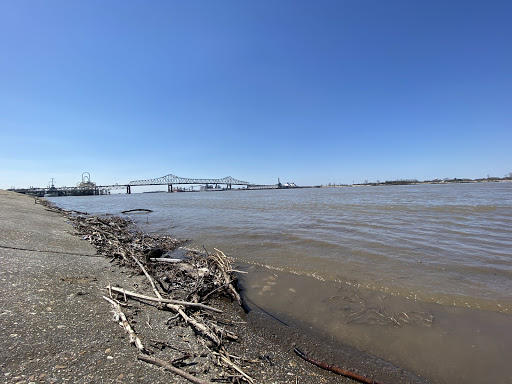Home → Lent Journey 2021 → Wednesday, March 17 — Compass Reading – Steering Toward Baton Rouge, Part 3

After pausing at Mount Zion First Baptist Church, I took the Downtown Greenway back north, then west, to the geographical limits of the city and parish: the Mississippi River, itself. Living in Baton Rouge, it’s interesting to reflect on our relationship with this giant feature. When I moved here, I thought it would play a direct role in the culture and identity of the city, but I see now our relationship to it is as a giant inconvenience more than a social touchstone.
In Wichita, where I grew up, the Arkansas River flows through the middle of the city, and yearly we celebrated the “Wichita River Festival,” crossing back and forth from bank to bank, on foot or by bike, for varieties of music and food and fun. It was both a source and cite of cultural pride. In Baton Rouge, crossing from east to west over the Mississippi is an endeavor that requires good timing, a gasoline-powered vehicle and a little luck. It’s a crossing made by necessity, not for entertainment.
However, the Mississippi River levee path has become a favorite route for my bike rides. It’s one of the few long stretches of pavement safe from vehicular traffic, and given a stiff north or south wind, I get the chance to open up the throttle and fly. But the levee path is still not the river itself — if anything, it’s a human structure meant to hem-in an immense force of nature, walling off both its fearsomeness and capacity from us. In flood stage, houses and factories in the shadow of the river look with concern to the forces pushing against and under the levee.
I’ve heard it said that the Mississippi River is like a super-highway running past Baton Rouge with no on-ramps as the only water from Baton Rouge that ends up in that great watercourse is what falls on the west side of the path on top of the levee. I still wonder, if back in 2016, we could have used the Mississippi as a conduit for the flood water, how much better off we might have been. As it is, the Mississippi has great commercial value to Baton Rouge, but is generally an uncomfortable neighbor we generally avoid encountering, if possible.
So, I headed to the Mississippi to encounter it as a river itself. Just behind the old rail station, now the Baton Rouge Museum of Science and Art, I scaled down the massive concrete steps to the winter-low water level. Before me, hundreds of thousands of cubic feet of water passed every second. Draining the wide midsection of the North American continent, I considered that waters from my hometown of Wichita, Kansas; waters from my college town near Ashland, Kentucky; and, waters from over 2000 miles away in Minnesota all mixed, churned, and flowed southward toward the Gulf.
Ironically, an empty plastic bottle of Dasani drinking water bobbed next to me. This river is an amazing thing, the way it washes our individual and corporate sins downstream without complaint or reservation. Kind of like how the blood of Christ washes us clean without concern or prejudice. Though I wouldn’t think of drinking the water of this river, its place in maintaining the natural process for our continent is undeniable. It’s a source of much life, an irreplaceable resource. The difference, of course, is that, by faith, we believe the blood of Christ has no limit to it’s purifying power. “Oh, precious is the flow that washed me white as snow!” This river, on the other hand, has a limit to what it can take. If the limitless blood of Christ is named precious, so too should we name the limited resource of our rivers.
I bent low to snap a picture of the river and sky. The low hum and drum of diesel engines and tires filled the air, but through the magic of photography I pushed the industrial skeleton of the new bridge, the tug boats and the man-made profile of the Port of Baton Rouge into the distance, leaving the peacefulness of the three basic forms of matter: water and earth and the azure blue vault of heaven stretching above.
As a boy, I read The Adventures of Huckleberry Finn, and I imagined what life was like floating on a raft down the Mississippi. Sitting in the middle of Baton Rouge, I knew I was far removed from the river that Mark Twain knew and loved. Yet, it was the same river; sometimes wild and untamed, sometimes placid, but always a steady flow in the same direction. Not unlike the God I believe in, a God whose grace and love is wild and untamed and always moving in the direction of a final redemption of all creation.
Buen Camino!
Rev. Dr. David Chisham
© 2021 All rights reserved.